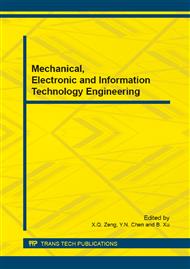[1]
Gergely Palla, Derényi Imre, Farkas Illés, et al., Uncovering the overlapping community structure of complex networks in nature and society, Nature, 435(2005) 814-818.
DOI: 10.1038/nature03607
Google Scholar
[2]
A. Arenas, Danon L., Diaz-Guilera A., et al., Community analysis in social networks, The European Physical Journal B-Condensed Matter and Complex Systems, 38(2004) 373-380.
DOI: 10.1140/epjb/e2004-00130-1
Google Scholar
[3]
Thomas Krichel, Bakkalbasi Nisa, A social network analysis of research collaboration in the economics community, Journal of Information Management and Scientometrics, 3(2006)1-12.
Google Scholar
[4]
A. L Barabási, Jeong H, Néda Z, et al., Evolution of the social network of scientific collaborations, Physica A: Statistical Mechanics and its Applications, 311(2002)590-614.
DOI: 10.1016/s0378-4371(02)00736-7
Google Scholar
[5]
Tianwei He, International scientific collaboration of China with the G7 countries, Scientometrics, 80(2009)573-584.
Google Scholar
[6]
M. E. J. Newman, Scientific collaboration networks. I. Network construction and fundamental results, Physical review letters, 64(2001)016131-016131~016138.
Google Scholar
[7]
M. E. J. Newman, Scientific collaboration networks. II. Shortest paths, weighted networks, and centrality, Physical Review, 64(2001)016132-016131~016137.
DOI: 10.1103/physreve.73.039906
Google Scholar
[8]
Xiaoming Liu, Bollen Johan, Nelson Michael L., et al., Co-authorship networks in the digital library research community, Information processing & management, 41(2005)1462-1480.
DOI: 10.1016/j.ipm.2005.03.012
Google Scholar
[9]
Ryutaro Ichise, Takeda Hideaki, Muraki Taichi, Research Community Mining with Topic Identification, In: the Tenth International Conference on Information Visualization, IEEE Press, New York, 2006, pp.276-281.
DOI: 10.1109/iv.2006.92
Google Scholar
[10]
Martin G. Everett, Analyzing clique overlap. Connections, 21(1998) 49-61.
Google Scholar
[11]
Alireza Abbasi, Hossain Liaquat, Uddin Shahadat, et al., Evolutionary dynamics of scientific collaboration networks: multi-levels and cross-time analysis, Scientometrics, 89(2011)687-710.
DOI: 10.1007/s11192-011-0463-1
Google Scholar
[12]
Aric A. Hagberg, Schult Daniel A., Swart Pieter J., Exploring network structure, dynamics, and function using NetworkX, Los Alamos National Laboratory (LANL). (2008)11-15.
Google Scholar
[13]
Andrea Lancichinetti, Fortunato Santo, Radicchi Filippo, Benchmark graphs for testing community detection algorithms, PHYSICAL REVIEW E, 78(2008)1-5.
DOI: 10.1103/physreve.78.046110
Google Scholar


